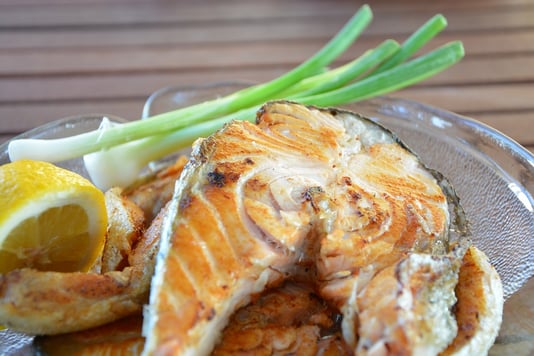 Maybe you’ve already mastered the perfect hamburger, the expertly prepared steak, and even gotten creative with your kebabs.
Maybe you’ve already mastered the perfect hamburger, the expertly prepared steak, and even gotten creative with your kebabs.
Ready for the next challenge? This week we’re talking about the process of grilling fish fillets.
Not only does fish have a distinctive and highly desired flavor, but it’s also one of the healthiest animal-based proteins available. Plus, fish is packed with essential nutritsn like vitamin D and omega-3s.
Let's get grilling!
Tools
You can cook thicker fillets, such as salmon steaks, directly on the grill grates. Be sure to clean the grates first. Once the grill is at the correct temperature (see below), you’ll want to brush the grate with oil before you start, and brush the fish with oil as well to prevent sticking.
For thinner cuts and more delicate fish such as tilapia, consider using a grill basket or wrapping the fish in aluminum foil (with oil and seasoning locked inside); otherwise the thin fillets are likely to fall apart on the grill.
You’ll also need paper towels to pat the fish dry before cooking, and seasoning and/or marinades of your choice.
Temperature
In order to get the fish to sear on the outside, you’ll want to pre-heat your gas grill to high and then reduce the temperature to medium, or about 350 to 400 degrees.
If you’re cooking on a charcoal grill, let the coals heat up, and then move them to one side of the grill to create a hot zone and a cooler zone. You’ll cook the fish on the cooler part of the grill.
Be sure to keep the cover down during cooking.
Turning
Grilling fish isn’t like a grilling a burger—you want to resist the temptation of turning it more than once. Let the fish cook fully on the first side (see “Timing” below), and then use a flat metal spatula to carefully peel the fillet off of the grill surface and flip it over to finish cooking on the other side.
Turning without breaking the fillet may require some practice. Placing the fish down at an angle (instead of keeping the grates in line with the natural sections of the fish) makes it easier to turn. Keeping the skin on can also help.
You may also want to experiment with using two spatulas or even a fork.
Timing
Fish fillets tend to be delicate and cook quickly, so you’ll need to monitor them carefully.
Estimate how thick your fillet is, and cook for approximately 8 to 10 minutes per inch. Be sure to split that time in half, though—for example, you’d cook for 4 minutes on one side, turn, and cook for about 4 minutes on the other.
Texture
Fully cooked fish has a firm texture, an opaque color, and flakes apart easily. It will also come off of the grill more easily than undercooked fish. Be sure to take the fillet off the grill as soon as it reaches the proper texture to avoid overcooking!
In the case of tuna steaks, many cooks like to sear the outside and leave the center a little rarer. Just be sure it’s a high quality fillet for safety’s sake.
Get grilling!
Ready to go? Try one of these popular recipes:
- Grilled Swordfish with Cucumber Salsa via Delish
- Grilled Salmon with Soy Sauce Marinade via AllRecipes
- Seared Tuna Steaks via Food Network
- Healthy Herbed fillets Grilled in Foil via Skinnytaste
And if you’re still shopping for a grill or are unhappy with the one you have, be sure to browse our large selection of gas and charcoal grills.

